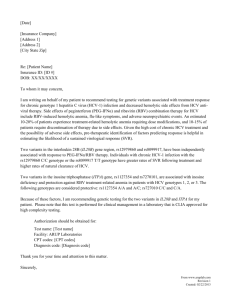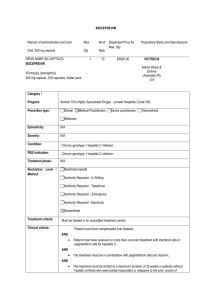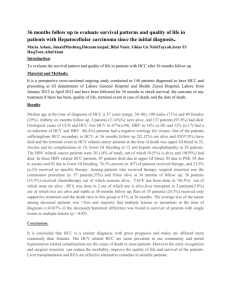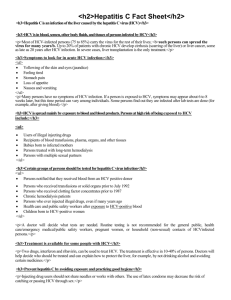hep26422-sup-0003-suppinfo
advertisement
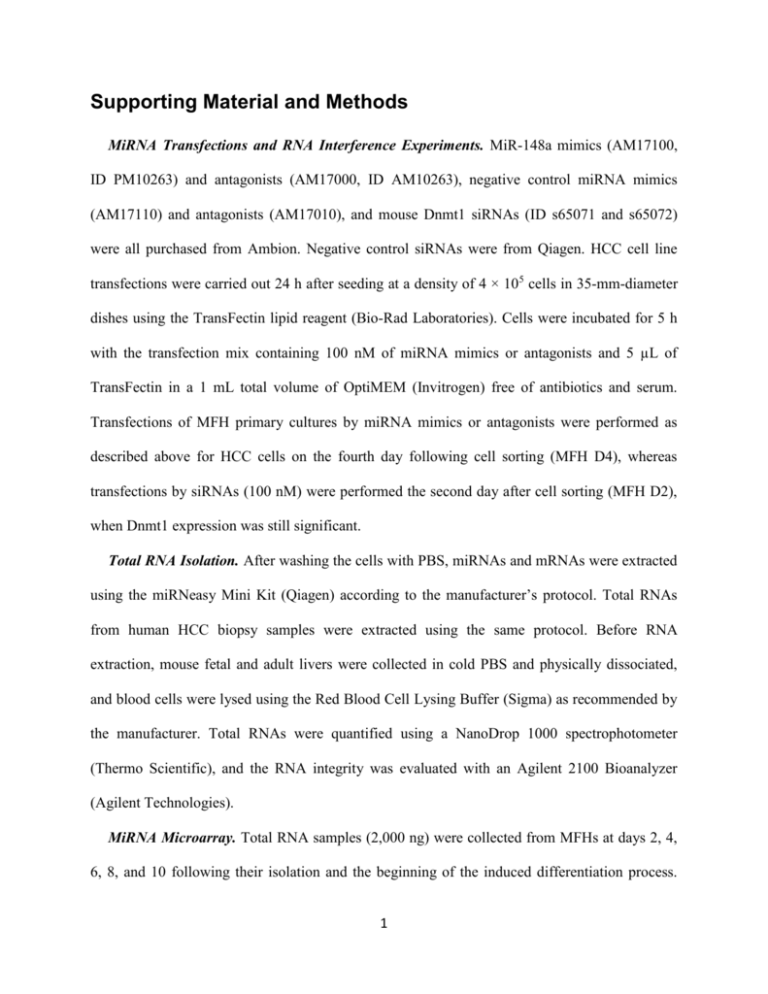
Supporting Material and Methods MiRNA Transfections and RNA Interference Experiments. MiR-148a mimics (AM17100, ID PM10263) and antagonists (AM17000, ID AM10263), negative control miRNA mimics (AM17110) and antagonists (AM17010), and mouse Dnmt1 siRNAs (ID s65071 and s65072) were all purchased from Ambion. Negative control siRNAs were from Qiagen. HCC cell line transfections were carried out 24 h after seeding at a density of 4 × 105 cells in 35-mm-diameter dishes using the TransFectin lipid reagent (Bio-Rad Laboratories). Cells were incubated for 5 h with the transfection mix containing 100 nM of miRNA mimics or antagonists and 5 µL of TransFectin in a 1 mL total volume of OptiMEM (Invitrogen) free of antibiotics and serum. Transfections of MFH primary cultures by miRNA mimics or antagonists were performed as described above for HCC cells on the fourth day following cell sorting (MFH D4), whereas transfections by siRNAs (100 nM) were performed the second day after cell sorting (MFH D2), when Dnmt1 expression was still significant. Total RNA Isolation. After washing the cells with PBS, miRNAs and mRNAs were extracted using the miRNeasy Mini Kit (Qiagen) according to the manufacturer’s protocol. Total RNAs from human HCC biopsy samples were extracted using the same protocol. Before RNA extraction, mouse fetal and adult livers were collected in cold PBS and physically dissociated, and blood cells were lysed using the Red Blood Cell Lysing Buffer (Sigma) as recommended by the manufacturer. Total RNAs were quantified using a NanoDrop 1000 spectrophotometer (Thermo Scientific), and the RNA integrity was evaluated with an Agilent 2100 Bioanalyzer (Agilent Technologies). MiRNA Microarray. Total RNA samples (2,000 ng) were collected from MFHs at days 2, 4, 6, 8, and 10 following their isolation and the beginning of the induced differentiation process. 1 RNA labeling and hybridization were performed using a human microRNA microarray kit (Agilent Technologies) according to the manufacturer’s protocol (Protocol for Use with Agilent MicroRNA Microarrays Version 1.5). Hybridization signals were detected using a DNA Microarray Scanner (Agilent Technologies), and the scanned images were analyzed using Agilent Feature Extraction software (v.10.7.3.1; Agilent Technologies). All the microarray data are shown in Supporting Table 1. We applied a 2-fold change in signal intensity to identify the significant differences of miRNA expression in this study. MiRNA and mRNA Real-Time Quantitative PCR. For miRNA analyses by real-time quantitative polymerase chain reaction (RT-qPCR), 100 ng of total RNA was reverse-transcribed using the Taqman miRNA Reverse Transcription Kit (Applied Biosystems). The expression levels of mature miR-148a, miR-148b, miR-152, and control RNU6B were determined by RTqPCR with the Taqman Universal PCR Master Mix in a 7300 Real-Time PCR System from Applied Biosystems. The PCR conditions were 50°C for 2 min and 95°C for 10 min, followed by 40 cycles of 95°C for 15 sec and 60°C for 1 min. Taqman probes from Applied Biosystems were used to assess the expression of the 3 miRNAs, which are conserved between mouse and human species: miR-148a (ID 000470), miR-148b (ID 000471), and miR-152 (ID 000475). The expression levels of miRNAs were normalized with respect to the endogenous levels of RNU6B (ID 001093). To determine mRNA expression, RNA samples were first treated with DNase using the TURBO DNA-free kit (Ambion). Then, cDNAs were synthesized from 1 µg of total RNA of each fraction using SuperScript III Reverse Transcriptase (Invitrogen) following the manufacturer’s recommendations. Finally, SYBR Green quantitative PCRs were performed to determine mRNA expression (Platinum SYBR Green qPCR SuperMix-UDG, Invitrogen). After an initial denaturation at 95°C for 2 min, the thermal cycles were repeated 40 times as follows: 2 95°C for 15 sec and 60°C for 30 sec. The GAPDH housekeeping gene was used to normalize the variations in the cDNA levels. The sequences of the primers used for gene amplification are shown in Supporting Table 3. Assessment of miR-148a Levels in the Serum of HCC Patients. The levels of circulating miR-148a in serum were analyzed from 11 HCC patients with underlying HCV infection. The isolation of extracellular miRNAs was performed using the miRNeasy Mini Kit (Qiagen) as described above. Importantly, RNAs were extracted from the same volume of serum (200 µL) for each sample. In addition, before phenol extraction, 0.1 nM of synthetic C. elegans miR-39 was added to each aliquot. C. elegans miR-39 expression was used as an invariant control from 200 µL of serum to normalize miR-148a expression data. Luciferase Reporter Assay. The 3’-UTR reporter plasmids were all purchased from GeneCopoeia, where the 3’-UTR sequences of DNMT1 (accession numbers NM_010066.3 and NM_001379.1 for mouse and human, respectively) or c-MET (NM_008591.2 and NM_000245.2 for mouse and human, respectively) were cloned downstream of the firefly luciferase reporter gene in the pEZX-MT01 vector. Renilla luciferase activity driven by a CMV promoter was used for normalization. Site-directed mutagenesis for the construction of mutated 3’-UTR vectors was performed in the seed sequences of mouse Dnmt1 and human DNMT1. PrimeSTAR Max DNA Polymerase (Takara, Japan) was used for PCR amplification. Forward primer and reverse primer sequences were as follows: mmu-Dnmt1-mut-Fw, ccacggtacatgatgtttttaaccctttgagcc; mmuDnmt1-mut-Rev, catcatgtaccgtggggctctgggtgagagca; caacagtacatgatgttgtgtttttaacatgtc; hsa-DNMT1-mut-Rev, hsa-DNMT1-mut-Fw, catcatgtactgttggggattcctggtgccaga. Simultaneous transfections were performed using 3’-UTR constructs (3 µg) and miRNA mimics (100 mM) in 35-mm-diameter dishes following the experimental procedure described above. 3 Empty vectors and control miRNA mimics were used as negative controls. Cells were collected 24 h after transfection, and proteins were extracted on ice using the M-PER Mammalian Protein Extraction Reagent (Thermo Scientific). The firefly-Renilla luciferase signals were assayed by the Dual-Glo Luciferase Assay System (Promega) using the Envision system (Wallac) as recommended by the manufacturer. Immunoblotting. Protein extraction was performed using M-PER Mammalian Protein Extraction Reagent (Thermo Scientific). Total protein (10 µg) was resolved by SDS-PAGE (10%) and transferred to nitrocellulose membranes for 1 h. Membranes were incubated overnight at 4°C with the following primary antibodies: anti-Dnmt1 (ab13537; abcam) and anti-Albumin (Santa Cruz; sc-46293) using appropriate dilution: 1/1,500 and 1/2,000, respectively. Anti-βTubulin (Sigma-Aldrich) at 1/1,500 was used as loading control. Antigen–antibody complexes were visualized by a chemiluminescence substrate procedure using the ECL Plus Western blotting detection system (GE Healthcare) and scanned with the Fujifilm LAS-3000 imaging system (Fujifilm). DNA Methylation Analysis. After washing the cells with PBS, Genomic DNAs were extracted using the GenElute Mammalian Genomic DNA Miniprep Kit (Sigma-Aldrich) according to the manufacturer’s protocol. DNA was quantified using a NanoDrop 1000 spectrophotometer (Thermo Scientific). Combined bisulfite restriction analysis (COBRA) was used for analyzing miR-148a and mouse albumin promoter methylation status. Briefly, genomic DNA was treated with sodium bisulfite using an EpiTect Plus kit (QIAGEN) and applied to PCR, followed by digestion with restriction enzymes. The primers used are summarized in Supporting Table 4. 4 Periodic Acid-Schiff (PAS) Staining. MFHs or mature-induced hepatocytes were fixed on ice for 5 min using glacial methanol. After 2 washes with PBS, PAS staining was performed using Schiff reagent, periodic acid, and hematoxylin (PAS Staining System Kit, Sigma) 5-Aza Treatment. To inhibit the global methylation status of DNA, cells were treated with 1, 2.5, and 5 µM of 5-aza-2’-deoxycytidine (5-Aza; Sigma) for 5 days. The drug and medium were replaced daily. Apoptotic Activity. Hepa 1-6 and HepG2 cells (4 × 105 cells in a 35-mm-diameter dish) were transfected with miR-148a mimics or controls as described above. Twenty-four hours after transfection, cells were treated with the apoptosis inducer TRAIL at 50 ng/mL (PeproTech) or left untreated. Cells were collected at the indicated times, and proteins were extracted with MPER (Thermo Scientific). Caspase-3/7 activity was assessed using the Apo-ONE Homogeneous Caspase-3/7 Assay (Promega) at an excitation wavelength of 480 nm and an emission wavelength of 520 nm using the Envision system (Wallac). Cell Growth Assay. Twenty-four hours after miRNA mimic or antagonist transfection, cells were seeded at 10,000 cells per well in 96-well plates, and cell viability was measured at the indicated times using the Tetra Color One assay kit (Seikagaku, Japan) according to the manufacturer’s instructions. The absorbance at 450 nm was measured using the Envision system (Wallac). Wound-Healing Assay. Hepa 1-6 cells were used for wound-healing assays. Twenty-four hours after transfection with miR-148a mimics or antagonists, five wounds per well were made by aspiration of the confluent cell layers using a plastic tip. Cells were washed twice with PBS to remove the detached cells and debris and maintained in DMEM supplemented with HGF (50 5 ng/mL). The sizes of the wounds were observed and measured at the indicated times using the ImageJ software (http://rsbweb.nih.gov/ij/). Transwell Invasion Assay. The invasion ability of Hepa 1-6 cells was assessed in 24-well Biocoat Matrigel invasion chambers with 8-µm pore size (BD Biosciences) according to the manufacturer’s recommended protocol. The day following miRNA mimic transfection, Hepa 1-6 were trypsinized, and 50,000 cells were plated in the upper chamber with a serum-free medium. The bottom chamber contained 10% FBS and HGF (100 ng/mL) as chemoattractants. Cells that migrated through the membrane were fixed with methanol 48 h later and stained using the DiffQuik staining kit (SYSMEX). Invasive cells were automatically counted using the ImageJ software, and the average number of cells per field was calculated. Statistical Analysis. Experimental data are presented as the mean ± SD. Student’s t-test was performed for the estimation of statistical significance between two groups of data. Equality of variances was tested using an F-test. All the P-values were two-tailed. Correlation analysis between miR-148a and DMNT1 expression level were assessed by calculating Spearman’s rank coefficient. Statistical significance of the miR-148a levels among normal livers, HCCs, and adjacent non-tumor tissues was assessed using the Mann-Whitney U-test. The miR-148a expression differences in HCC liver biopsies between tissue pairs (tumors and their corresponding adjacent non-tumor areas) were compared by the Wilcoxon signed-rank test. All statistical assessments were performed using MedCalc software. A result was considered statistically significant at P < 0.05. Experimental data and RT-qPCR profiles shown in this article are representative of at least three independent experiments. 6 Supporting Table 1. Microarray data. (see attached Excel file) 7 Supporting Table 2. Clinical data from HCC patients, normal livers, and fetal livers. Patient number Gender Age 1 2 3 4 5 6 7 8 9 10 11 12 13 14 15 M M F M M M M M M M M F F M M 62 36 58 58 56 58 56 67 63 41 68 40 57 61 61 Virus serology HBV HBV HBV HBV HBV HBV HBV HBV HBV HBV HBV HBV HBV HBV 16 17 18 M M F 44 60 51 HBV HBV HBV HBV 19 20 21 22 23 24 25 26 27 28 29 30 31 32 33 M F M M M M M M M M F M M M F 66 77 70 71 63 55 52 69 62 65 62 62 66 59 72 HCV HCV HCV HCV HCV HCV HCV HCV HCV HCV HCV HCV HCV HCV HCV Clinical history Chronic hepatitis Chronic hepatitis Chronic hepatitis Liver cirrhosis Chronic hepatitis Precirrhosis Precirrhosis Chronic hepatitis Chronic hepatitis Precirrhosis Chronic hepatitis Liver cirrhosis Chronic hepatitis Chronic hepatitis Precirrhosis 8 Precirrhosis Liver cirrhosis Chronic hepatitis Chronic hepatitis Liver cirrhosis Chronic hepatitis Chronic hepatitis Liver cirrhosis Liver cirrhosis Chronic hepatitis Chronic hepatitis Chronic hepatitis Chronic hepatitis Liver cirrhosis Liver cirrhosis Precirrhosis Chronic hepatitis Precirrhosis 34 35 36 37 38 39 F F M M F F 69 61 65 68 57 74 HCV HCV HCV HCV HCV HCV Chronic hepatitis Precirrhosis Liver cirrhosis Precirrhosis Precirrhosis Liver cirrhosis N01 N02 N03 N04 N05 N06 N07 N08 N09 N10 N11 N12 N13 M F M M F F M M M M M M M 71 62 46 80 65 63 57 61 55 54 64 71 71 non B/C non B/C non B/C non B/C non B/C non B/C non B/C non B/C non B/C non B/C non B/C non B/C non B/C F01 F02 F03 F04 F05 M M/F F F M 18-20 w 22-40 w 20 w 20 w 24 w N/A N/A N/A N/A N/A Leukemia Colon cancer metastasis Colon cancer metastasis Neuroendocrine cancer metastasis Leukemia Gastric cancer metastasis Colorectal cancer metastasis Neuroendocrine cancer metastasis Colon cancer metastasis Colorectal cancer metastasis Intracranial hemorrhage Unknown Unknown Pool of 3 (18, 20, and 18 weeks) Pool of 63 Single abortus Single abortus Single abortus HBV and HCV-related HCC samples included tumor and non-tumor tissues for each patient. 9 Supporting Table 3. List of primers used for RT-qPCR. Gene Name Sense Antisense glyceraldehyde 3-phosphatase dehydrogenase alpha-fetoprotein albumin glucose-6-phosphatase tyrosine aminotransferase cytokeratin 19 DNA methyltransferase 1 DNA methyltransferase 3a DNA methyltransferase 3b hepatocyte growth factor receptor (HGFR) cytochrome P450 17A1 (steroid 17-alpha-monooxygenase) cytochrome P450 17A1 equivalent to human CYP3A4 cytochrome P450 1a2 cytochrome P450 3a41 cytochrome P450 3a44 acccagaagactgtggatgg cacattgggggtaggaacac gaagcaagccctgtgaactc aggcgactatctccagcaaa atgactttgggatccagtcg gccaatcctggacagaacat caccatgcaaaacctcaatg cccaaagaaggatcctgtga accaggccacctacaacaag acttggtgattggtggaagc cgatcagcagtctgtgcatt ccgagaaatctgcagtgaca cctcaacaaaatcagcagca tggaaccagatgggaaagag ttctgaaggtgccgcttact caaggcgtgttctgtctcaa cttgatgtctgcctcgttga tgcttgttctgcacttccac ccagaagaatggacggttgt acagccggaagagtttctca tggtcatatgcatgccaact cccttcttcacgagcacttc ctgcatgttcccaaaggatt gactgggctgtgatctccat cactaacggcaagagcatga gattccctcaacaacccaga tcatttggagtgaacgtgga agcttgctgacgagatggtt aatcctttgggaacatgcag attagaatccaggcggcttt glyceraldehyde 3-phosphatase dehydrogenase alpha-fetoprotein albumin DNA methyltransferase 1 gagtcaacggatttggtcgt ttgattttggagggatctcg agcttggtggtggatgaaac ccagagatttcccaaagctg gagctaccacgcagacatca tctgcaatgacagcctcaag tgggatttttccaacagagg cgaggaagtagaagcggttg Mouse Gapdh Afp Alb G6pc Tat Ck19 Dnmt1 Dnmt3a Dnmt3b c-Met Cyp17a1 Cyp3a11 Cyp1a2 Cyp3a41 Cyp3a44 Human GAPDH AFP ALB DNMT1 All primers were designed using Primer3 v.0.4.0 (http://frodo.wi.mit.edu/primer3) and purchased from Invitrogen. 10 Supporting Table 4. List of primers used for COBRA. Primer name Primer sequence Primer position hsa-miR-148a-B1 hsa-miR-148a-B2 TTTTTGTTGGGTATTTGTTTTTGTT ACACTTAAACCCCCTCTAACCTTAC S1701 AS2074 mmu-miR-148a-B1 mmu-miR-148a-B2 TTTTTTTTATTGGATTTTTATTTTT CAAATTCTTCACAAAACCCTTATAC S316 AS718 hALB-B3 hALB-B4 GGTAGTTAATGAAATATAAAGATGAGTTTA AAAATTACCCACTTCATTATACCAAAA S312 AS460 mAlb-B5 mAlb-B6 TGTTGTTTTATATAATTTTAATGAATGGAT TTACCCACTTCATTTTACCAAAAAC S56 AS344 11
